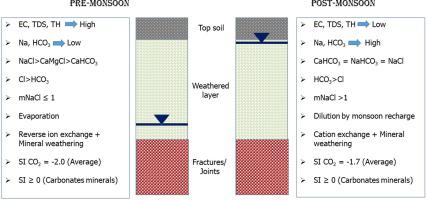Catena ( IF 5.4 ) Pub Date : 2020-07-03 , DOI: 10.1016/j.catena.2020.104766 E. Manikandan , N. Rajmohan , S. Anbazhagan

|
Impact of monsoon recharge on groundwater chemistry and geochemical processes was evaluated using geochemical methods in the shallow hard-rock aquifer, southern India. Groundwater samples were collected from Salem city and its outskirts during pre-monsoon (PRM) and post-monsoon (PM) seasons and analysed for major and minor ions. Results suggest that during PRM, the average concentration of TDS, major ions and electrical conductivity (EC) in groundwater are higher than the PM season except for Na+ and HCO3–. The major water types also varied with seasons (PRM: NaCl > CaMgCl > CaHCO3; PM: CaHCO3 = NaHCO3 = NaCl). Pearson correlation analysis indicates that Cl− and SO42− show a strong positive correlation with EC, TDS, TH and major cations during PRM season whereas HCO3– and NO3– have a strong positive correlation with most of the ions during PM season. Before monsoon, the water chemistry is governed by the weathering of carbonate and silicate minerals, reverse ion exchange and evaporation processes, which resulted in high EC, TDS, TH and major ions in the groundwater. After the monsoon, the water chemistry is regulated by the mineral weathering, cation exchange and dilution processes. Geochemical modelling studies indicate that groundwater is saturated and oversaturated with carbonate minerals and undersaturated with sulphate and chloride minerals. During monsoon, the recharging water flushed the weathered layer and dissolved the soil CO2 in the vadose zone, which subsequently enhanced the concentration of Na+ and HCO3– in the aquifer. Further, the high concentrations of Cl−, SO42- and NO3– imply that the aquifer is polluted by surface contamination sources. After the monsoon, NO3– implies that monsoon recharge facilitated the pollutant movement from surface to the aquifer. Hence, a proper aquifer management plan is required to protect this aquifer and to provide clean and safe drinking water to the local community.
中文翻译:

季风对浅层硬岩含水层中地下水化学和地球化学过程的影响
在印度南部浅层硬岩含水层中,使用地球化学方法评估了季风补给对地下水化学和地球化学过程的影响。在季风前(PRM)和季风后(PM)季节从塞勒姆市及其郊区采集地下水样品,并分析其中的主要离子和次要离子。结果表明,PRM时,TDS,主要离子及地下水电导率(EC)的平均浓度比PM季节除了更高的Na +和HCO 3 - 。主要水类型也随季节而变化(PRM:NaCl> CaMgCl> CaHCO 3; PM:CaHCO 3 = NaHCO 3 = NaCl)。Pearson相关分析表明,氯-和SO4 2−在PRM季节与EC,TDS,TH和主要阳离子呈强正相关,而HCO 3 –和NO 3 –在PM季节与大多数离子有很强的正相关性。在季风之前,水化学受碳酸盐和硅酸盐矿物的风化,反向离子交换和蒸发过程的控制,这导致地下水中的高EC,TDS,TH和主要离子。季风过后,水的化学成分受矿物风化,阳离子交换和稀释过程的调节。地球化学模型研究表明,地下水被碳酸盐矿物饱和和过饱和,而被硫酸盐和氯化物矿物饱和。在季风,再充电水冲洗风化层并溶解土壤CO 2在渗流区,其随后增强的Na的浓度+和HCO 3 -在含水层中。此外,高浓度的Cl -,SO 4 2-和NO 3 -暗示含水层是由表面污染源的污染。季风之后,NO 3 –表示季风补给促进了污染物从地表到含水层的移动。因此,需要适当的含水层管理计划来保护该含水层并向当地社区提供清洁和安全的饮用水。











































 京公网安备 11010802027423号
京公网安备 11010802027423号